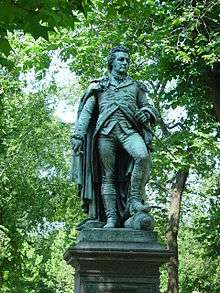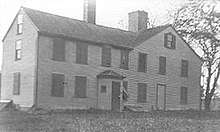John Glover (general)
John Glover (November 5, 1732 – January 30, 1797) was an American fisherman, merchant, and military leader from Marblehead, Massachusetts, who served as a brigadier general in the Continental Army during the American Revolutionary War.
John Glover | |
|---|---|
 | |
| Born | November 5, 1732 Salem, Province of Massachusetts |
| Died | January 30, 1797 (aged 64) |
| Occupation | Cordwainer, Fisherman, Rum trader, Merchant |
| Spouse(s) | Hannah Gale Frances Fosdick |
| Signature | |
Early life
Glover was born in Salem, Province of Massachusetts, the son of a house carpenter. When John was four years old, his father died. Shortly thereafter, his family moved to the nearby town of Marblehead.[1] As a young man, Glover became a cordwainer and rum trader and eventually a ship owner and merchant.[2] He married Hannah Gale in October 1754.[3]
Following the Boston Massacre in 1770, Committees of Correspondence were formed. Marblehead elected Glover along with future revolutionists Elbridge Gerry and Azor Orne to committee posts.[4] After the First Continental Congress passed the non-importation agreements sanctioning trade with the British, Glover was elected to enforce the embargo as a member of the committee of inspection.
Military career

Glover was active in the militia for many years before the Revolution, with his earliest service dating back to 1759.[5] In 1775 he was elected lieutenant colonel of the 21st Massachusetts Regiment from Marblehead, and became commander of the unit after the death of Colonel Jeremiah Lee in April 1775. Glover marched his regiment to join the siege of Boston in June 1775. At Boston, General George Washington chartered Glover's schooner Hannah to raid British supply vessels, the first of many privateers or warship authorized by Washington. For this reason the Hannah has been occasionally called the first vessel of the Continental Navy or its later successor the United States Navy.

The Marblehead militia or "Glover's Regiment" became the 14th Continental Regiment. This regiment became known as the "amphibious regiment" for their vital nautical skills. It was composed almost entirely of seamen, mariners and fishermen.[6] After Washington lost the Battle of Long Island (aka Battle of Brooklyn) in August 1776, Glover's Marbleheaders evacuated the army across the East River to Manhattan Island in a surprise nighttime operation, saving them from being entrapped in their fortified trenches on Brooklyn Heights.[7] In subsequent actions of the New York campaign the regiment fought well against the British at Kip's Bay when the Redcoats invaded, landing on Manhattan and Pell's Point. The last action of the regiment was its most famous: ferrying Washington's army on confiscated river coal ore boats from upstream across the Delaware River at night for a surprise attack on Hessian forces at the Battle of Trenton in New Jersey on the morning of December 26, 1776. The regiment was disbanded as enlistments expired at year's end.
Glover went home to tend to his sick wife and look to business affairs. He turned down a promotion to brigadier general in February 1777, but rejoined the war and accepted the promotion after a personal appeal from General Washington. As commander of a brigade made up of four Massachusetts regiments, he served in the successful Saratoga campaign along the Hudson River in the summer and fall of 1777 and the failed Battle of Rhode Island in 1778. He was stationed along the Hudson River for the remainder of the war, guarding against British moves up the river from New York City.
Later life
Hannah, Glover's first wife, died in 1778. He married again, in 1781, to widow Frances (Hitchborn) Fosdick. He retired from the army in 1782 in poor health, and returned to his business interests. He served in local offices including town selectman, delegate to the state convention that ratified the U.S. Constitution (1788), and member of the Massachusetts House of Representatives (1788-1789). He retired to Glover Farm in 1782[8], on the border of Marblehead and Swampscott which he purchased after the war from the state from property that once belonged to a British loyalist. The house and farm property still exist today, having been converted to an Inn, and then restaurant before closing in the late 1990s and left abandoned today.[9] He died in Marblehead in 1797 after contracting hepatitis and was buried in Old Burial Hill (Marblehead, Massachusetts).[10]

Memorials

On November 20, 1783, he was awarded the charter for the town of Glover, Vermont, as its prime proprietor, in honor of his service.[11]
Fort Glover in Marblehead, originally built for the Revolutionary War as the Huit's Head Battery, was named for him when rebuilt in the Civil War.
The frigate USS Glover (FF-1098) was named for him.
Glover's Rock in the Bronx is a memorial to him.
Glover School in Marblehead was named after him in 1916.
There is a statue of Glover on Commonwealth Avenue in Boston.
The General John Glover House is located in Marblehead.
Glover Field in Pelham, New York is named for him.
Glover's Regiment
In honor of General Glover's Legacy, founded for the bicentennial, and continue to this day, a dedicated group of re-enactors take part in special events throughout the year commemorating the achievements of Glover and his regiment.[12]
Books
- History and Traditions of Marblehead by Samuel Roads
- General John Glover and His Marblehead Mariners by George Bilias
Popular culture
In the 2000 television movie The Crossing, the part of Glover is a pivotal character, and played by Sebastian Roché.[13]
Notes
- Billias p.17
- Billias p.18
- Billias p.21
- Billias p.33
- Billias p.60
- Wilson, J. G.; Fiske, J., eds. (1900). . Appletons' Cyclopædia of American Biography. New York: D. Appleton.
- "Glover's Regiment Crossing Delaware".
- "Marblehead Magazine Timeline".
- "General Glover House Restaurant".
- Billias p.200
- Gazetteer of Lamoille and Orleans Counties, VT.; 1883-1884, Compiled and Published by Hamilton Child; May 1887
- "Glover's Regiment".
- Video on YouTube, The Crossing, opening credits, retrieved January 3, 2018
References
- Billias, George Athan (1960). General John Glover and his Marblehead Mariners. New York: Holt, Rinehart and Winston.
- Fowler, William M. "Glover, John". American National Biography Online, February 2000.
- General John Glover and His Marblehead Mariners by George Bilias. 1903